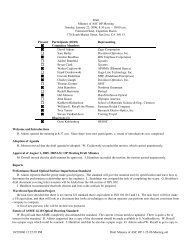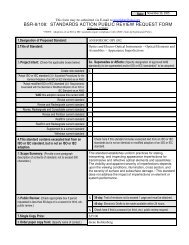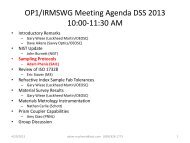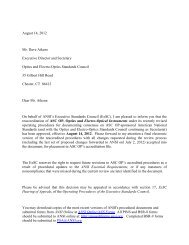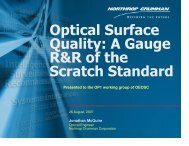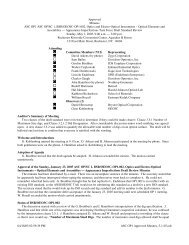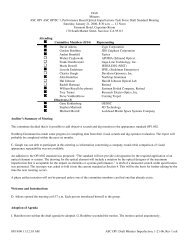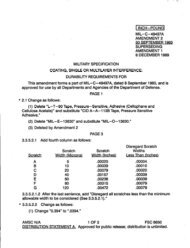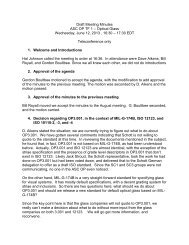INCH-POUND MIL-PRF-13830B 9 January 1997 SUPERSEDING ...
INCH-POUND MIL-PRF-13830B 9 January 1997 SUPERSEDING ...
INCH-POUND MIL-PRF-13830B 9 January 1997 SUPERSEDING ...
You also want an ePaper? Increase the reach of your titles
YUMPU automatically turns print PDFs into web optimized ePapers that Google loves.
<strong>MIL</strong>-<strong>PRF</strong>-<strong>13830B</strong><br />
APPENDIX E<br />
and multiplied by 100 shall constitute the percent of water soluble material. Failure<br />
of the sample shall be cause for rejection of the lot (see E.3.3).<br />
E.4.5.3 Oil resistance. Approximately 2 g of the sealing compound shall be<br />
spread uniformly on one side of a 1 by 4 in. (2.5 by 10.1 cm) aluminum panel. The<br />
aluminum shall be solvent degreased before immersing in 3% alkaline cleaner (90%<br />
sodium metasilicate and 10% Aerosol OT-B) at 80°C (176°F) for 5 minutes, washing<br />
in running tap water, immersing in dichromate solution (85 grams of sodium<br />
dichromate, not less than 99% by weight, and 250 ml of concentrated sulfuric acid,<br />
93% by weight min. to 2 liters of distilled water) at 75°C (167°F) for 5 minutes,<br />
washing in running tap water and distilled water and drying. The sample shall then<br />
be partially immersed for 96 hours in oil conforming to Oil No. 2 (ASTM D471). The<br />
test shall be conducted at room temperature. The panel shall be removed and the<br />
sample examined for evidence of blistering, softening and lack of adhesion. Test shall<br />
be performed in duplicate. Failure of either sample shall be cause for rejection of the<br />
lot (see E.3.4).<br />
E.4.5.4 Adhesion. Test shall be made as described in ASTM D897 except that<br />
there shall be 3 types of specimens: (a) steel specimens as described in ASTM D897;<br />
(b) steel specimens with a thin glass wafer bonded with suitable adhesive (epoxy resin<br />
base) to the steel working surfaces; (c) steel specimen with a polyacrylic plastic<br />
(conforming to ASTM D4802) wafer bonded to the working surface. The sealing<br />
compound shall be applied to both surfaces. The specimen shall be compressed<br />
under a load of 200 lb. (90 kg) for about 20 seconds to insure a minimum gap<br />
between the adherents of the specimen. The prepared specimen shall be conditioned<br />
at room temperature 22° - 25°C (72° - 77°F) for 49 hours prior to testing. The bond<br />
strength of the assembly shall be measured in a tensile testing machine whose jaw<br />
separation speed is 1-in. per minute. The specimens shall be examined for failure in<br />
cohesion of the sealing material. Test shall be performed in duplicate. Failure of the<br />
sample shall be cause for rejection of the lot (see E.3.5).<br />
E.4.5.5 Aging. The consistency of the sealing compound shall be determined in<br />
the original condition and after aging for 24 hours at 65°“ 1°C (150° “ 2°F). The<br />
sample shall be tested in accordance with ASTM D217 tested for unworked<br />
penetration, using a 150 g total load for 5 seconds. Four readings shall be taken on<br />
each sample. More than one unsatisfactory reading shall be cause for rejection of the<br />
lot (see E.3.6).<br />
E.4.5.6 Effect of volatile components. A 5-6 g sample of the sealing compound<br />
shall be placed on a 2 in. (5.0 cm) diameter watch glass and then placed in an<br />
enclosed vessel which contains a polished polymethylmethacrylate (conforming to<br />
73<br />
Source: http://www.assistdocs.com -- Downloaded: 2006-05-24T15:32Z<br />
Check the source to verify that this is the current version before use.



